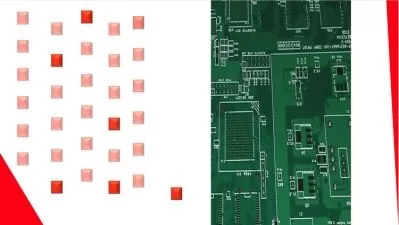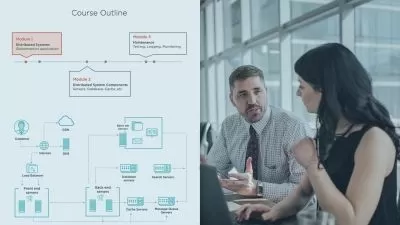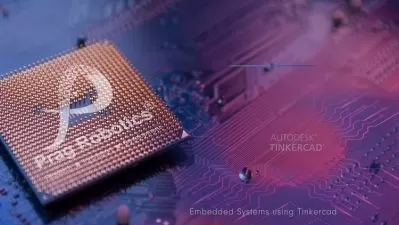Embedded Systems - Introduction to Microprocessors - MSP430
Afterclap Academy
7:51:40
Description
Hand-on Introduction to Embedded Systems, Microprocessors Adventure with MSP430.
What You'll Learn?
- Introduction to microprocessors and microcontroller systems
- MSP430 architecture and memory organization
- Input/output interfaces and programming
- MSP430 programming using Code Composer Studio IDE
- Interrupt handling and timer modules
- Analog-to-digital and digital-to-analog conversion
- Interfacing MSP430 with sensors and actuators
Who is this for?
What You Need to Know?
More details
DescriptionWelcome to the "Introduction to Microprocessors-MSP430" course! This course is designed to provide students with a comprehensive understanding of microprocessor and microcontroller systems, with a focus on programming the MSP430 microcontroller.
Throughout the course, students will learn about the fundamentals of microprocessor architecture, memory organization, and input/output (I/O) interfaces. They will also learn how to program the MSP430 microcontroller using the C programming language, and how to use development tools such as the MSP430 LaunchPad development board and Code Composer Studio Integrated Development Environment (IDE).
The course will cover a range of topics, including:
- MSP430 architecture and memory organization
- Input/output interfaces and programming
- MSP430 programming using Code Composer Studio IDE
- Interrupt handling and timer modules
- Analog-to-digital and digital-to-analog conversion
- Serial communication protocols (e.g. I2C, SPI, UART)
- Interfacing MSP430 with sensors and actuators
In addition to theoretical concepts, the course will also include hands-on exercises and projects, allowing students to apply their knowledge in practice. By the end of the course, students will have gained a strong foundation in microprocessor and microcontroller systems and will be equipped with the skills to develop applications for embedded systems using the MSP430 microcontroller.
This course is suitable for students pursuing degrees in electrical and computer engineering, computer science, or related fields. It is also ideal for hobbyists and enthusiasts interested in developing applications for embedded systems using the MSP430 microcontroller. Prior programming experience is not required, although a basic understanding of the C programming language would be beneficial.
Enroll now to gain a solid foundation in microprocessor and microcontroller systems and to develop your skills in programming the MSP430 microcontroller!!!
Who this course is for:
- designed for learners who are interested in learning the fundamentals of microprocessor and microcontroller systems.
- This course is particularly suitable for students pursuing degrees in electrical and computer engineering, computer science, or related fields.
- This course is also ideal for hobbyists and enthusiasts who are interested in developing applications for embedded systems using the MSP430 microcontroller.
- This course is designed for learners who are eager to learn new concepts and are willing to put in the time and effort required to complete the assignments and projects.
- Overall, this course is intended for learners who are looking to expand their knowledge and skills in microprocessor and microcontroller systems, and who are interested in developing applications for embedded systems using the MSP430 microcontroller.
Welcome to the "Introduction to Microprocessors-MSP430" course! This course is designed to provide students with a comprehensive understanding of microprocessor and microcontroller systems, with a focus on programming the MSP430 microcontroller.
Throughout the course, students will learn about the fundamentals of microprocessor architecture, memory organization, and input/output (I/O) interfaces. They will also learn how to program the MSP430 microcontroller using the C programming language, and how to use development tools such as the MSP430 LaunchPad development board and Code Composer Studio Integrated Development Environment (IDE).
The course will cover a range of topics, including:
- MSP430 architecture and memory organization
- Input/output interfaces and programming
- MSP430 programming using Code Composer Studio IDE
- Interrupt handling and timer modules
- Analog-to-digital and digital-to-analog conversion
- Serial communication protocols (e.g. I2C, SPI, UART)
- Interfacing MSP430 with sensors and actuators
In addition to theoretical concepts, the course will also include hands-on exercises and projects, allowing students to apply their knowledge in practice. By the end of the course, students will have gained a strong foundation in microprocessor and microcontroller systems and will be equipped with the skills to develop applications for embedded systems using the MSP430 microcontroller.
This course is suitable for students pursuing degrees in electrical and computer engineering, computer science, or related fields. It is also ideal for hobbyists and enthusiasts interested in developing applications for embedded systems using the MSP430 microcontroller. Prior programming experience is not required, although a basic understanding of the C programming language would be beneficial.
Enroll now to gain a solid foundation in microprocessor and microcontroller systems and to develop your skills in programming the MSP430 microcontroller!!!
Who this course is for:
- designed for learners who are interested in learning the fundamentals of microprocessor and microcontroller systems.
- This course is particularly suitable for students pursuing degrees in electrical and computer engineering, computer science, or related fields.
- This course is also ideal for hobbyists and enthusiasts who are interested in developing applications for embedded systems using the MSP430 microcontroller.
- This course is designed for learners who are eager to learn new concepts and are willing to put in the time and effort required to complete the assignments and projects.
- Overall, this course is intended for learners who are looking to expand their knowledge and skills in microprocessor and microcontroller systems, and who are interested in developing applications for embedded systems using the MSP430 microcontroller.
User Reviews
Rating
Afterclap Academy
Instructor's Courses
Udemy
View courses Udemy- language english
- Training sessions 62
- duration 7:51:40
- Release Date 2023/06/11











